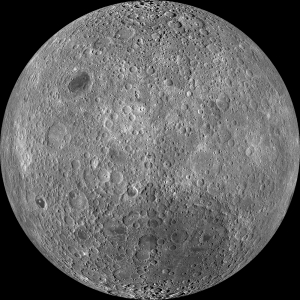A familiar face on the lunar surface, commonly called the “man in the Moon,” has inspired superstition and myth for generations on Earth, but scientists have concerned themselves more with theories about the geological origins of the large lava beds that form the vague image.
Ralph Metcalfe, UH professor of mechanical engineering, published a theory about lava bed formation on the Moon, which he developed as a University of Washington undergraduate student in 1968. He and his professor, Nils Barricelli, proposed that collisions with moonlets that also orbited the Earth billions of years ago could have caused the large lava-filled lunar impact basins. Analysis of computer simulations of Earth satellite orbits provided a consistent explanation for the predominance of maria near the lunar equator on the side of the moon facing the Earth. In 1970, a summary of their study appeared in the first edition of The Moon, a journal founded by Harold Urey, winner of the 1934 Nobel Prize in chemistry.
After earning his Ph.D. in applied math at M.I.T. with doctoral adviser Steven Orszag, Metcalfe contributed to the reality of past and future Moon missions with his early professional work in direct numerical simulations of turbulent flows. This included research for NASA involving generation of jet noise by turbulence, the evolution of axisymmetric turbulent wakes and the effects of turbulence on chemically reacting mixing layers.
Although Metcalfe has focused on fluid mechanics for the last 30 years, his optimism about future missions to the Moon and potential Moon colonies was renewed when astronaut and professor Bonnie J. Dunbar joined the UH faculty as director of the aerospace engineering graduate program in 2013.
“I’ve always been interested in going back to the Moon,” Metcalfe said. “And my feeling is that the Moon is much more realistic in terms of a time scale than Mars, though I think we should go there, too.”
Gravitational forces, which hold the same side of the Moon facing Earth at all times, kept the far side of the Moon a mystery until the Soviets launched the Luna 3 spacecraft in 1959. The spacecraft snapped the first photographs of the unfamiliar side, and the images sparked immediate curiosity among scientists. The far side’s mountainous terrain was almost entirely free of huge lava beds, which was very different from the lunar surface facing Earth. Metcalfe and Barricelli speculated that evolution of the system comprised of the early Earth, Moon and satellites could have caused the surface inconsistencies on opposite sides of the Moon.
“Many scientists have thought that the lava beds were of volcanic origin,” Metcalfe said. “But that doesn’t explain why the lava beds are concentrated around the equator on only one side of the Moon.”
The planets in the solar system that orbit closest to the Sun have fewer moons than those that orbit farthest from the Sun. For example, Mercury and Venus are moonless, Earth has one Moon, Mars has two and Jupiter and Saturn have dozens. Metcalfe and Barricelli proposed that the planets currently without moons had them earlier in the evolutionary cycle, and that those with few moons had more at one time.
Metcalfe developed computer software to simulate the Earth-Moon system’s interaction with moonlets like those that currently orbit more distant planets Jupiter and Saturn. He plotted the courses of the moonlets along with those of the Earth and the Moon.
Based on tidal theory, scientists already knew that the Moon spiraled away from the Earth about one-and-a-half inches per year, which put it 10 times farther away than it was four billion years earlier. Metcalfe’s simulations showed that the Moon destabilized the orbits of the moonlets as it moved away from the Earth. The moonlets either departed the Earth-Moon system, moved closer to Earth, collided with Earth or crashed into the Moon. The most compelling evidence for the Metcalfe/Barricelli theory was that most of the moonlet collisions with the Moon happened on only one side near the equator.
Based on kinetic energy, Metcalfe estimated that the moonlets that hit the Moon traveled about 2.4 kilometers per second, which would produce enough energy to melt the moonlets and some of the Moon rock into large, circular lava pools. The concentration of impact basins around the Moon’s equator is also consistent with the small orbital inclinations of the inner satellites of Jupiter, Saturn and Uranus.
The satellite impact basins should be distinguished from the impacts of asteroids and comets from outside the Earth-Moon system, which would strike the Moon moving more than 10 kilometers per second. The increased speed could account for craters such as Kepler and Copernicus with significant amounts of ejected material as indicated by outward radiating rays. Such collisions would produce enough energy to melt and vaporize the rock, which could blow the majority of the molten lava out of the crater.
Furthermore, the collision theory could explain gravitational anomalies detected in the centers of many of the lava beds by lunar orbiters. Moonlets with heavy nickel-iron cores would melt upon impact and sink to the bottoms of the craters.
“The lava beds on the Moon could have resulted from impact, volcanism or both,” Metcalfe said. “That’s why we’re so interested in going back to the Moon to test these theories with real lunar geology.”
A careful study of lunar geology should also provide more examples of asteroid and comet impacts, shedding light on the formation of the Chicxulub crater in the Gulf of Mexico whose impact may have contributed to the mass extinction of 75 percent of plant and animal species on Earth 66 million years ago, Metcalfe said.
